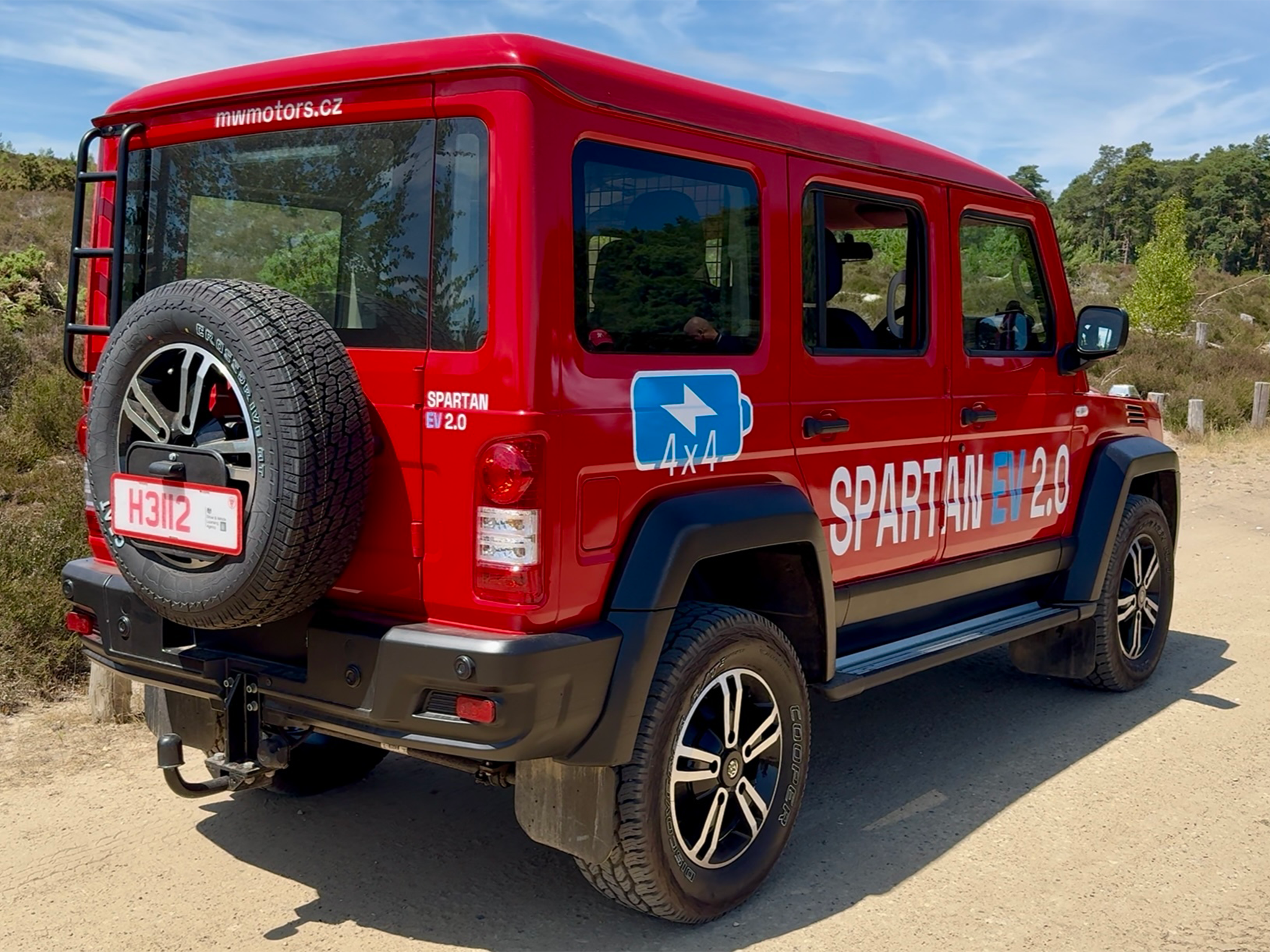
When off-roading in the unspoilt countryside, doesn’t it make sense to want to drive a zero-emissions 4x4? Strange, then, that there isn’t a whole heap of them to choose from. In that respect, the Spartan EV 2.0 is well worth a look.
It’s an interesting car with international DNA. Using an Indian-built 4x4 as its base, it’s imported without its engine and gearbox into the Czech Republic by MW Motors, owned by Irish entrepreneur Maurice Ward (hence the MW), and converted into a proper EV using Chinese-made battery tech.
Much of the original car’s 4x4 gubbins remain, including front and low and high-ratio settings plus front and rear differential locks, so the specs are those of a proper off-roader. And sure enough, we took the Spartan over a pretty serious off-road track for some muddy fun – and it acquitted itself well.
The interior is a bit, well, spartan, but there are enough niceties in there. If you want more than four seats in the long-wheelbase car, you can get two more in the boot that you have to access through the boot door. The same applies if you want four seats in the short-wheelbase model. Quirks aside, the Spartan rumbles along okay on country lanes and around town – better than some other serious 4x4s.
But the sticking point is the price. If you’re an eco-minded business needing a 4x4 workhorse, avoiding the VAT makes the Spartan look like a reasonable bet. Adding 20 per cent on for non-business buyers makes it look a bit pricey.
That said, you can have an MG Cyberster for similar money, and while the MG isn’t the greatest track day car, you can have as much fun off-road in a Spartan than you might have on a track day. And a trip down a picturesque green lane is free fun – you can’t say that about a race track.
How we tested
We were given exclusive access to the Spartan EV on the muddy ruts and hills through the trees at Surrey 4x4 Tours & Training near Aldershot in Hampshire. As well as testing the Spartan off-road, we also took to nearby roads to test its on-road ability, while checking out everything else that’s important to off-roader buyers.
Spartan EV 2.0: From £58,294, Mwmotors.cv

Independent rating: 7/10
- Pros: Excellent off-road ability, reasonable on-road manners, good fun
- Cons: The Spartan name applies to the interior, odd seating layout, order times, pricey with VAT
Spartan EV 2.0 specs
- Price range: £58,294 to £64,206
- Battery size: 61kWh
- Maximum claimed range:150 miles
- Miles per kWh: 2.53
- Maximum charging rate: 90kW
Battery, range, charging, performance and drive
Whether you go for the three-door short-wheelbase Spartan or the five-door long-wheelbase model that we drove, you get the same 61kWh battery. The smaller car claims a range of 150 miles. That drops to 142 miles for the five-door model. Both cars get DC fast-charging at up to 90kW on a suitable charger, giving a 20 to 80 per cent charge in 36 minutes.
You’ll be surprised how well that range lasts when you’re off-roading. EVs are always at their best when tackling slower jobs – a motorway is not their preferred home – and that’s the case with the Spartan. The brick-like aerodynamics and hefty weight will mean frequent stops if you’ve long distances to cover. But for a day’s off-roading you’ll probably have enough charge, while local runarounds will mean less frequent charging, too.
Driving this EV off road is not like a petrol or diesel off-roader. For starters, the car won’t just trundle on on tickover – you have to tickle the throttle a bit to tease the car forwards, then it’s the usual balancing act with the power feeding in gently, or more abruptly, as the off-road conditions demand.

There’s also none of the natural engine braking that gives a petrol or diesel off-roader its control as you move downhill. Instead, there’s an electronic hill descent control that works with the electric motor to limit downhill speed to as little as 1mph.
Then there’s the steering, which is a more direct rack-and-pinion system than the traditional off-roading recirculating ball steering. It not overly reactive off-road, but the real benefit is on-road where there’ll be less arm twirling. And when you are on-road, the suspension is surprisingly compliant. It’s clear that you’re in a car focused on rougher stuff, but it’s calm enough to be used around town, with acceleration that’s not exactly sprightly but quick enough.
The combination of the clever hill descent control tech and slick automatic gear selector with a more traditional lever that needs some heft to move through high and low-ratio settings is a little odd, but should please traditionalists. As will the levers that need similar brute force to lock the front or rear diffs to give you extra traction if the going gets really slippery.
With the batteries under the bonnet, there’s no worries of huge expense from repairs if you clatter the underside of the car. It’s as solid as you’d expect and there’s good ground clearance and excellent grip, although our car was on proper off-road rubber. And yes, an EV can go through water – the Spartan has a wading depth of 700mm.

The difference in behaviour of an all-electric off-roader doesn’t take much getting used to and you soon get into the swing of off-roading without the familiar rumbles and growls that you get with an internal combustion engine under the bonnet. You hear plenty of electronic clicks and whines, but it all adds to the fun of what is a very capable bit of off-roading kit.
Interior, practicality and boot space
Spartan by name, spartan by nature. There are plenty of hard, cheap-feeling plastics inside the EV 2.0, but they feel in keeping with the car and are at least easy to wipe clean. Quality seems good though, with no squeaks or rattles that we could detect, other than those coming from our passenger as we went off road.
The front seats are comfortable, the driving position is good and there’s space for odds and ends behind and around the various levers in between the front seats.
If you want rear seats in the three-door car you can only get two and you have to access them through the side-opening boot door. It’s the same if you want five or six seats in the five-door car – they’ll live in the boot as the standard model comes with four captain’s chairs. At least climbing in through the back will add to the fun, if not make it especially easy for the less able.

There’s decent boot space without rear seats fitted, with 1,718 litres of room in the three-door car, rising to a huge 2,597 litres in the five-door model – with lots of height for luggage and people. It’s a super-spacious car with a good view out, too. The square corners with G-Class-style lights on top of the front wings help you to place the car through trees or traffic.
Technology, stereo and infotainment
Let’s be honest, this isn’t the most high-tech EV you’ll drive, although some of the clever off-roading tech we’ve mentioned is pretty impressive.
Inside, there’s an 8in touchscreen which will come with Apple CarPlay and Android Auto connectivity, then there’s an old-school kit count which boasts air-con, electric windows, rear parking sensors and central locking.
You can choose to get a vehicle-to-load adaptor, too, which will help power three-pin accessories if you take your Spartan off camping in the wilderness, but other than a roof rack and ladder, there are none of the fancy tent options you can get with some off-roaders these days.
Prices and running costs
The price is the biggest sticking point for a vehicle that looks and feels cheap in places, even if the off-road ability is impressive. If you’ve got an eco-friendly business that needs to access places normal cars won’t reach, then the Spartan makes sense with pre-VAT prices of £48,995 for the three-door and £53,505.

Adding VAT takes the more family-friendly five door up to a whopping £64,206. Much as we like the Spartan EV 2.0, that’s a difficult price to justify.
As you’d expect, running costs will be on the higher side, with efficiency of 2.53 miles per kWh on a good day, although you might say that’s the price of having fun amongst nature.
Playing with the Spartan configurator on its website reveals a choice of just four colours: a no-cost white or metallic red, and green or black for an extra £399 whether you go for the three- or five-door car.
If you do fancy a Spartan, be aware that MW Motors doesn’t hold stock in the UK and a factory order might take up to six months to arrive.
Spartan EV 2.0 rivals
FAQs
How long does it take to charge?
Both cars support DC fast-charging up to 90kW on a suitable charger, allowing for a 20 to 80 percent charge in 36 minutes.
How much does it cost - is it worth it?
The high price is a major concern for a vehicle that seems cheaply made, despite its robust off-road capabilities. For eco-friendly businesses needing access to remote areas, the Spartan is practical with pre-VAT prices of £48,995 for the three-door and £53,505.
Why trust us
Our team of motoring experts have decades of experience driving, reviewing and reporting on the latest EV cars, and our verdicts are reached with every kind of driver in mind. We thoroughly test drive every car we recommend, so you can be sure our verdicts are honest, unbiased and authentic.
The verdict: Spartan EV 2.0
The Spartan EV 2.0 is a double-edged sword – it’s as impressive off-road as other 4x4s with an engine, with the rugged looks and wipe-clean interior serious off-roaders need. It made me smile, but the price is steep, especially when VAT is added on, taking you into (non-EV admittedly, but serious 4x4) Ineos Grenadier territory.
Ford Explorer review: Stylish electric SUV is every inch a Ford
The 10 best Tesla alternatives 2025: Our favourite rivals to Elon Musk’s EVs
Best long-range electric cars 2025: Top 12 EVs that go the distance
Ford Ranger PHEV review: The best-selling pick-up goes plug-in hybrid
Best small electric cars 2025: Top 11 affordable compact EVs to buy now
Best electric cars 2025: Top 10 EVs to buy and the ones to avoid
Fiat Grande Panda goes wild with new 4x4
Zeekr 7X review: The best premium electric SUV you can’t buy (yet)







